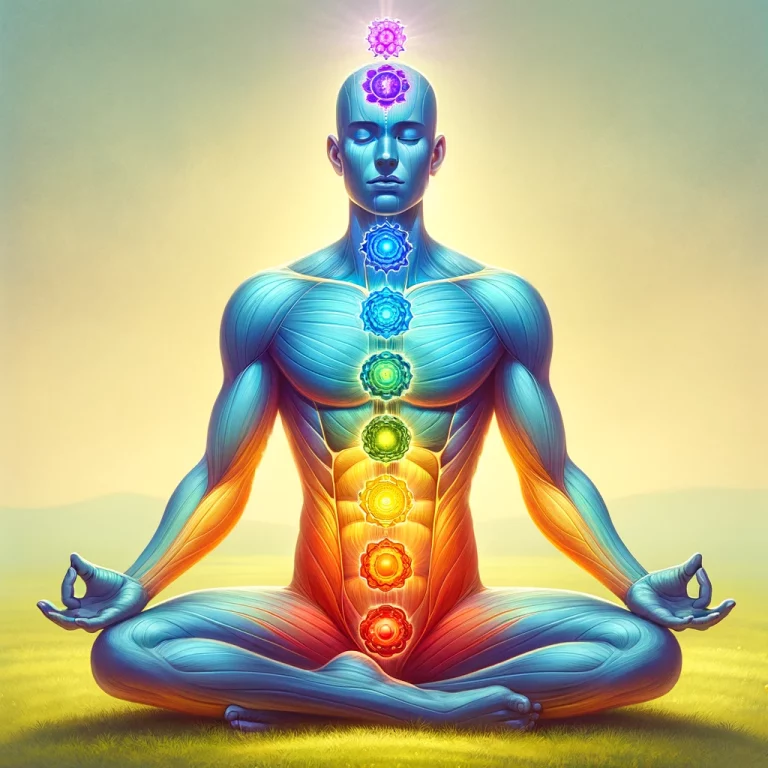Are Chakras really the Key to Holistic Health and Happiness in Yoga and Ayurveda?

In both yoga and Ayurveda, the concept of chakras holds significant importance, representing the energetic centers within the body. These centers are believed to influence physical, mental, and emotional well-being, and understanding them can deepen our yoga practice and overall sense of balance. Let’s delve into what chakras are, their significance, and a brief overview of each one.
What Are Chakras?
Chakras, meaning “wheels” or “circles” in Sanskrit, are spinning energy centers located along the central axis of the body, from the base of the spine to the crown of the head. The study and knowledge of the chakras spans centuries and practices, from various yoga to Buddhism to Jainism schools of thought, and they are used for a variety of purposes, starting with understanding our energy body, and the connection between our physical and energy body. In yoga and Ayurveda, it’s understood that there are seven main chakras (though many more in total), each associated with specific qualities, elements, colors, sounds, and areas of life. Chakras are the focal points of prana (which corresponds to ki or chi), the universal life force and energy in the body.
In Yoga, chakras are considered fundamental knowledge. Each yoga pose or asana corresponds to at least one, and oftentimes more than one chakra. In a well-rounded yoga class, we may touch upon all seven of them, though one may also choose a practice focusing on only one chakra, or a combination of chakras. Therefore, for example, a grounding and stabilizing yoga class may include poses activating the root and sacral chakra. Beyond just the asana, kriyas (actions), pranayama (breathwork), and various meditation techniques may be rooted in specific chakra work, and all teach how chakra energy centers are important aspects of the practice. The process of raising the Kundalini energy is related to the chakras as well, as the Kundalini is dormant at the level of root and sacral chakra, and the goal of raising Kundalini Shakti is for this energy to reach the crown chakra and beyond.
In Ayurveda, chakras are related to understanding not only the physical body, corresponding to a way of understanding energetic anatomy, but are also a bridge between all five layers or koshas, namely the physical, energy, mental and emotional, intellectual, and spiritual bodies. Knowledge of the chakras is used in diagnostics and treatments, where various practices from yoga to pranayama to basti, to even lifestyle activities and practices, are used to balance the chakras. Various Ayurvedic treatments correlate to the chakras, and upon diagnosing any blockages or imbalances, can be used to treat, balance, or energize the chakras. One of the most popular and universally beneficial Ayurvedic treatments, the Shirodhara oil bath, where oil is poured on the forehead, is considered to be stimulating for the sixth chakra or the third eye.
Beyond yoga poses and Ayurvedic treatments, practices such as sound healing meditation (where each sound vibration or a singing bowl, be it crystal or metal, can be attuned to chakra frequencies), mudras, or hand gestures, mantras chanting, activate the chakras as well. Various energy healing practices such as Reiki are also rooted in Chakra knowledge and can provide balancing.

Chakras at a Glance
1. Root Chakra (Muladhara)
- Color: Red
- Element: Earth
- Mantra: Lam
- Area of Life: Survival, stability, security
- Yoga Poses: Mountain Pose (Tadasana), Warrior I (Virabhadrasana I)
2. Sacral Chakra (Svadhishthana)
- Color: Orange
- Element: Water
- Mantra: Vam
- Area of Life: Creativity, emotions, sensuality
- Yoga Poses: Bound Angle Pose (Baddha Konasana), Crescent Lunge (Anjaneyasana)
3. Solar Plexus Chakra (Manipura)
- Color: Yellow
- Element: Fire
- Mantra: Ram
- Area of Life: Personal power, confidence, willpower
- Yoga Poses: Boat Pose (Navasana), Warrior III (Virabhadrasana III)
4. Heart Chakra (Anahata)
- Color: Green
- Element: Air
- Mantra: Yam
- Area of Life: Love, compassion, relationships
- Yoga Poses: Bridge Pose (Setu Bandhasana), Camel Pose (Ustrasana)
5. Throat Chakra (Vishuddha)
- Color: Blue
- Element: Ether
- Mantra: Ham
- Area of Life: Communication, self-expression, truth
- Yoga Poses: Fish Pose (Matsyasana), Shoulder Stand (Sarvangasana)
6. Third Eye Chakra (Ajna)
- Color: Indigo
- Element: Light
- Mantra: Om or Aum
- Area of Life: Intuition, perception, insight
- Yoga Poses: Child’s Pose (Balasana), Corpse Pose (Shavasana)
7. Crown Chakra (Sahasrara)
- Color: UltraViolet or White
- Element: Thought
- Mantra: Silence or Om
- Area of Life: Spirituality, enlightenment, connection to the divine
- Yoga Poses: Headstand (Sirsasana), Lotus Pose (Padmasana)

Why Are Chakras Important?
Understanding and balancing the chakras can help bring harmony to our physical, emotional, and spiritual selves. When the energy flows freely through each chakra, we experience a sense of vitality, balance, and well-being. By incorporating yoga poses, meditation, breathwork, and other practices targeted at specific chakras, we can work towards aligning and balancing these energy centers.
At Hari OM school, we offer comprehensive Ayurveda and yoga courses where we delve deeply into the understanding and significance of the chakras. Our courses integrate chakra-based diagnostics, therapy suggestions, and yoga class sequencing, empowering practitioners and teachers to harness the power of the chakras for holistic well-being and transformation. Join us on this journey of self-discovery and inner harmony.
Best Hari OM courses to learn about the chakras:
Note: Remember to adapt yoga poses according to individual abilities and consult with a qualified yoga instructor or healthcare professional if you have any concerns or medical conditions.
Ready to Deepen Your Ayurveda & Yoga Journey?
Explore our specialized programs to harmonize your life with ancient wisdom.


